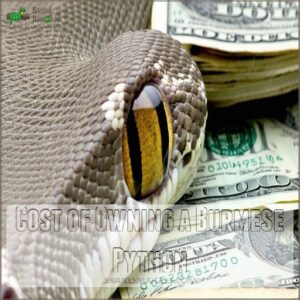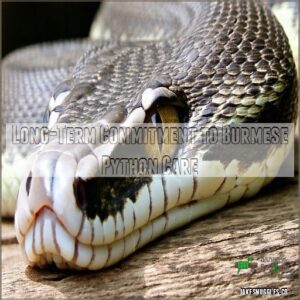This site is supported by our readers. We may earn a commission, at no cost to you, if you purchase through links.

With potential lengths of over 20 feet, they’re not for the faint-hearted—or the small-apartment dwellers!
You’ll need a sizable budget for a comfy enclosure, heat supplies, and a steady supply of rodent meals.
Plus, legal hoops might jump out at you, depending on your local laws.
They live over 20 years, so think of it as more than a weekend fling.
While they’re generally mild-mannered giants, handling needs care to avoid any slippery situations.
Ready for a snake that’s legendary in the Everglades? Dive deeper—there’s more to learn!
Table Of Contents
- Key Takeaways
- Burmese Python Habitat and Distribution
- Is a Burmese Python a Good Pet
- Burmese Python Care and Maintenance
- Feeding Your Burmese Python
- Burmese Python Health Issues
- Handling and Safety Precautions
- Cost of Owning a Burmese Python
- Laws and Regulations on Burmese Python Ownership
- Behavioral Considerations for Burmese Python Owners
- Long-Term Commitment to Burmese Python Care
- Frequently Asked Questions (FAQs)
- Conclusion
Key Takeaways
- You’ll need ample space and a significant budget for Burmese python ownership, including a secure 8x4x4-foot enclosure, heating, and food costs.
- It’s crucial to check local laws and permits, as Burmese python ownership may involve strict regulations and legal requirements.
- Handling these large snakes requires care, understanding their body language, and ensuring a safe environment to prevent escapes or aggression.
- Owning a Burmese python is a long-term commitment, with potential lifespans exceeding 20 years, demanding ongoing care and thoughtful attention.
Burmese Python Habitat and Distribution
Burmese pythons are native to Southeast Asia, where they thrive in diverse habitats like forests, marshes, and grasslands.
These adaptable reptiles have also made quite a name for themselves in the Florida Everglades, causing a bit of chaos among the local wildlife.
Native Range and Invasive Regions
Burmese pythons, originally from Southeast Asia, now roam beyond their native range.
Thanks to the exotic pet trade, these introduced species have become notorious invasive species.
In the U.S., they’ve especially taken to places like the Florida Everglades.
Their invasive habitat impacts local wildlife, prompting vital conservation efforts to curb their growing numbers.
Everglades Ecosystem and Its Challenges
Everglades, once a paradise for native critters, now faces a slippery challenge.
Properly setting up a safe Burmese python enclosure is essential to prevent these snakes from escaping and further disrupting the ecosystem.
As invasive species go, the Burmese python is a heavyweight.
These giant snakes cause ecosystem disruption, gobbling up wildlife and outcompeting natives.
The Florida Everglades feels the squeeze, prompting urgent conservation efforts and wildlife protection to restore balance.
Can the Everglades bounce back from this serpentine invasion?
Is a Burmese Python a Good Pet
Considering a Burmese python as a pet is like adopting a teenager who never outgrows their need for constant attention and room to stretch.
Before you invite this impressive serpent into your home, weigh the responsibility of its long lifespan and substantial care requirements.
Factors to Consider Before Ownership
Thinking of adding a Burmese python to your family? Consider these key factors.
- Space: Burmese pythons grow large, demanding a big habitat, with enclosures ideally at least 8 feet long, 4 feet wide, and 4 feet tall for an adult python care requirements.
- Budget: Factor in setup and ongoing costs; they’re not light on the wallet.
- Legality: Check local laws; owning one might involve permits.
Understand these aspects to make sure you’re a responsible owner.
Pet Suitability and Responsibility
Before getting a Burmese python, consider your lifestyle.
These aren’t cuddly pets; they need serious space.
Ethical concerns exist; responsible breeders are key.
Legal implications and potential hazards are real.
Think carefully about handling; it’s vital for safety.
Are you truly prepared for the long-term commitment?
Burmese python ownership demands responsibility.
Burmese Python Care and Maintenance
To keep your Burmese python healthy and happy, you’ll need to create a cozy home that mimics its natural environment, complete with the right temperature and humidity.
Think of it as building a tropical resort for a very discerning guest who insists on basking spots and misty mornings.
Housing Requirements and Design
Choosing the right enclosure for your Burmese python means considering its size and habits.
These snakes grow large, so an appropriately sized habitat setup is essential.
Use a secure enclosure with a tiled or aspen substrate.
Incorporate water features and hideouts to mimic its natural environment.
This helps meet your python’s care needs, providing space for exploration and rest.
Environmental Essentials and Temperature Control
Creating a comfy space for your Burmese python means focusing on environmental essentials and temperature control.
Think of it like their own personal spa retreat.
Keep it cozy with:
- Heating: Use heat mats or lamps.
- Ventilation: Make sure there’s airflow to prevent mold.
- Substrate: Choose bedding like aspen shavings.
Manage thermostats carefully for optimum burmese python health.
Humidity Levels and Lighting Needs
For your Burmese python’s health, maintaining humidity levels around 50-70% helps with shedding and overall comfort in their enclosure.
A quality hygrometer helps you precisely control humidity.
To further optimize your Burmese python’s environment, refer to Burmese python care sheets that emphasize the importance of a temperature gradient.
Regarding lighting, while UVB isn’t necessary, providing a consistent day-night cycle with an appropriate lighting setup helps mimic natural conditions, supporting your python’s well-being in its habitat.
Feeding Your Burmese Python
Feeding your Burmese python is a bit like preparing a gourmet meal—minus the truffle oil and fancy plating.
You’ll need to think about its nutritional needs and establish a feeding schedule that fits both its growth stage and appetite, making sure it’s as satisfied as a snake at an all-you-can-eat buffet.
Nutritional Needs and Prey Options
Ever wondered what a Burmese python craves for dinner?
These hefty reptiles thrive on a varied diet of appropriately sized prey like large rodents.
Opt for frozen-thawed over live prey to avoid injuries.
Prey should match your python’s girth for easy digestion.
Nutritional supplements and gut loading can boost health, enhancing your snake’s charmingly voracious appetite!
Feeding Schedule and Frequency
Now that we’ve covered what your Burmese python should eat, let’s talk about how often.
Younger snakes need more frequent meals than adults.
Think of it like a growth spurt – they’re building muscle and need fuel!
Adult feeding usually involves a larger meal, less often.
Overfeeding’s a real risk, so always match prey size to your snake’s girth.
A good rule of thumb is to offer food roughly the size of the thickest part of your snake’s body.
Regular weighing helps monitor your snake’s weight and adjust the schedule as needed.
Remember, a happy snake is a healthy snake!
Burmese Python Health Issues
When it comes to the health of your Burmese python, recognizing common issues like respiratory infections and mites is important to keeping them happy and thriving.
You’ll need to stay vigilant, just as you’d keep an eye on your pet goldfish’s suspicious bubble-blowing antics during breakfast.
Common Health Problems and Symptoms
Burmese pythons can face several health issues, including respiratory troubles, shedding problems, and digestive hiccups like regurgitation.
Stress can lead to obesity, while nutritional deficiencies may cause metabolic bone disease.
Regular parasite treatment, such as using products for Python parasite treatment, is essential to prevent parasite infections.
Parasite infections are another concern. Keep a sharp eye out for symptoms like labored breathing or unusual lethargy.
Remember, a healthy python’s smooth scales and glossy eyes are signs of wellness.
Veterinary Care and Precautions
It’s important to select a knowledgeable veterinarian for your Burmese python.
They’re adept at parasite prevention and disease diagnosis.
Consider these four essentials:
- Enrichment Needs: Provide a stimulating environment.
- Snake Handling: Handle with care to avoid stress-related health issues.
- Reptile Nutritionist: Consult for the best feeding strategies.
- Health Monitoring: Regular checkups to address issues like regurgitation or prey size concerns.
Handling and Safety Precautions
When handling your Burmese python, it’s important to use safe techniques to make sure both your safety and the snake’s well-being.
Familiarizing yourself with your python’s behavior can prevent misunderstandings and make interactions smoother, even if it sometimes feels like a reptile version of a staring contest.
Safe Handling Techniques and Equipment
Handling your python safely can be as tricky as juggling apples.
Use handling gloves to protect yourself and your Burmese python – you can find suitable options at python handling gloves.
Secure enclosures are a must to prevent Houdini-like escapes.
Safe transport includes firm support underneath.
Here’s a quick guide:
| Safety Aspect | Importance |
|---|---|
| Handling Gloves | Protects both parties |
| Secure Enclosures | Prevents escapes |
| Safe Transport Setup | Ensures stability |
Understanding Burmese Python Behavior
Understanding snake behavior is like reading a mystery novel—full of twists and turns.
When handling a Burmese python, observe its temperament through:
- Body language cues: flicking tongue, coiled body.
- Nocturnal habits: active at night, resting during the day.
- Defensive behaviors: hissing, striking if threatened.
Engage wisely, respect their needs, and you’ll unravel their intriguing nature.
Cost of Owning a Burmese Python
Owning a Burmese python isn’t cheap; you’ll need to factor in the initial cost of the snake, a suitable enclosure, and essential equipment.
Beyond that, ongoing expenses like food, veterinary care, and potential enclosure upgrades will add up—think of it as a significant long-term investment, similar to owning a fancy sports car, but with scales instead of chrome.
Initial Purchase Price and Setup Costs
Bringing a Burmese python home as a pet starts with budgeting.
Initial costs include the python, its enclosure, and other necessities.
Check out the table below for a quick overview:
| Item | Estimated Cost |
|---|---|
| Burmese Python Price | $150 – $500 |
| Enclosure Size | $200 – $500 |
| Heating Equipment | $50 – $150 |
| Humidity Control | $30 – $100 |
These investments will help your new friend thrive.
Ongoing Expenses and Feeding Costs
You’ve set up the vivarium, and now it’s time to plan your Burmese python’s groceries.
The ongoing cost includes prey size matching the burmese python pet food needs, like frozen/thawed rats weekly.
Burmese python feeding schedule impacts the wallet too.
Consulting a reptile nutritionist helps create balanced diets, preventing costly health issues.
However, it’s important to also consider the overall expenses of owning a snake, including initial adoption fees ranging from $15-$1,000+, initial snake costs.
Consider surprise expenses for dietary variety and supplements.
Laws and Regulations on Burmese Python Ownership
Before you decide to adopt a Burmese python as a pet, you must navigate a jungle of national and state laws, permit requirements, and local regulations.
These rules can vary greatly, so it’s important to stay informed.
Nobody wants to end up with a snake and a fine!
National and State Laws on Python Ownership
Before diving into Burmese python ownership, know that laws and regulations vary.
Federal laws ban importation and limit interstate sale.
State regulations can be stricter, reflecting local ecosystems’ needs.
Consider these key points:
- Research State Laws: Restrictions differ by state.
- Federal Guidelines: Know the inter-state transport rules.
- Compliance: Stay updated on any changes.
Permit Requirements and Local Regulations
Understanding the maze of python ownership laws is like wrestling a slippery snake.
Local regulations often require permit applications to keep that Burmese python curled in your living room.
Some states, such as Arizona, Florida, and Texas, allow venomous snake ownership with a license, which can be obtained by following specific state laws on owning venomous snakes as pets.
Ownership restrictions can vary, so legal compliance is key.
Always check the specific requirements in your area before considering a Burmese python for sale; it’s both a responsibility and a fascinating adventure!
Behavioral Considerations for Burmese Python Owners
Owning a Burmese python means you’ll become quite the snake psychologist, tuning into their body language and mood swings to keep things smooth.
Understanding their temperament is key to managing stress and preventing any unexpected escalations, like a cranky friend at a party.
Understanding Temperament and Body Language
Burmese pythons, despite their size, possess surprisingly nuanced body language. Understanding their temperament is key to safe handling.
Look for these signs:
- A relaxed snake will have a calm demeanor.
- Defensive postures include a flattened body and hissed warnings.
- Observe their behavior closely to learn their individual quirks. Careful observation helps guarantee a harmonious relationship.
Managing Stress and Aggression
Understanding your Burmese python’s temperament can feel like cracking a mystery.
When stress triggers arise, consider environmental factors—like temperature and space—to ease tension.
Recognizing signs of stress and aggression, such as body language and posturing, is also essential in providing the right environment.
Enrichment strategies, such as varied textures or scents, offer engagement.
Practice gentle handling techniques; socialize early to foster trust.
Think of it as dance choreography—graceful moves prevent aggression, important for responsible python care.
Long-Term Commitment to Burmese Python Care
When you choose to care for a Burmese python, you’re looking at a commitment that can last several decades.
These snakes often live over 20 years.
It’s like that "forever" friendship you promised in high school, but with more scales and fewer prom photos.
Expected Lifespan and Care Duration
You’re in it for the long haul with a Burmese python, whose lifespan can creep up to 25 years if cared for properly.
Think of it as adopting a pet with a pension.
This hefty commitment might lighten your wallet but consider it a challenge worth accepting.
With patience and dedication, you’ll master the art of reptile care.
Planning for The Future and Rehoming Options
Plan ahead to make sure your Burmese python finds a suitable home.
Considering rehoming options is a must for long-term commitment.
Here’s how:
- Research ethical rehoming resources: Connect with reptile rescues and forums.
- Consider legal requirements: Some states require permits to rehome.
- Be proactive: Engage with the best Burmese python breeder for guidance.
Keep it ethical; never release them into the wild!
Frequently Asked Questions (FAQs)
Where do Burmese pythons live?
Burmese pythons are originally from Southeast Asia. Sadly, they’ve become invasive in Florida’s Everglades, thriving in its warm climate and abundant prey.
Are Burmese pythons invasive?
Yes, they’re invasive.
Introduced in Florida’s Everglades, Burmese pythons outcompete native wildlife, lacking natural predators.
They disrupt ecosystems by preying on local species, causing significant ecological imbalances.
Efforts are ongoing to control their population.
How big is a Burmese python?
Imagine a creature that stretches as long as a small car.
Burmese pythons can grow over 16 feet and weigh more than 200 pounds.
That’s heavier than some Great Danes!
They’re real giants of the reptile world.
What do Burmese pythons eat in Florida?
In Florida, you’d find Burmese pythons feasting on a smorgasbord of mammals, birds, and reptiles.
They’re not picky eaters, targeting everything from rabbits and raccoons to wading birds, disrupting local ecosystems with their voracious appetites.
What do Burmese pythons eat?
Burmese pythons primarily devour diverse dishes—from mammals like rabbits and deer to birds and reptiles.
With stealthy stalking and powerful constriction, they enjoy a smorgasbord of prey, impacting ecosystems where they roam, like Florida’s Everglades.
Conclusion
Having a Burmese python pet isn’t just a walk in the park.
These stunning creatures require careful planning and commitment, from housing and feeding to dealing with legal hurdles.
Make sure you’re ready to provide consistent care throughout their long lives.
With the right setup and understanding, keeping a Burmese python can be an incredibly rewarding experience.
They’re unique companions demanding both responsibility and a sense of adventure.
Embrace the challenge, and you might find a lifelong friend.



















